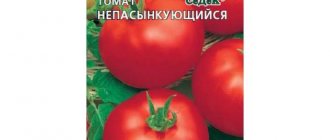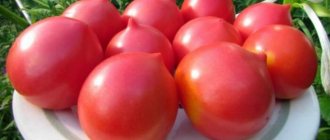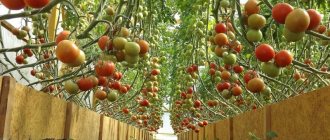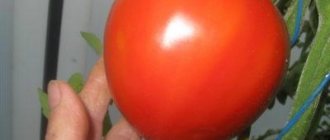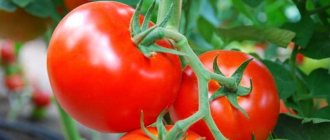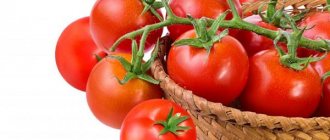Raspberry miracle is a whole series of hybrid tomatoes of 15 varieties. Tomatoes have attractive appearance and pleasant taste, and their ease of care makes them a real boon for vegetable growers and consumers. Before planting this variety, familiarize yourself with its characteristics and study the “pitfalls” (if any).
Origin of tomatoes Raspberry miracle
The tomatoes were obtained by breeders from Gardens of Russia. The work was completed more than 12 years ago, as a result of which 3 series of tomatoes of 5 varieties each with individual characteristics were identified.
After receiving a gold medal in 2014 at an agricultural exhibition, all tomato varieties were included in the State Register of Vegetable Crops. The selection of tomatoes did not stop there.
Raspberry Miracle tomatoes have strong immunity and resistance to a number of diseases. These varieties have taken root well in all regions of Russia and provide a rich harvest at minimal cost.
Useful video
We invite you to familiarize yourself with the description and recommendations for growing tomatoes from the “Golden Raspberry Miracle” series in the following video:
In the table below you will find useful links about tomato varieties with different ripening periods:
| Mid-late | Mid-early | Super early |
| Volgogradsky 5 95 | Pink Bush F1 | Labrador |
| Krasnobay F1 | Flamingo | Leopold |
| Honey fireworks | Mystery of nature | Shchelkovsky early |
| De Barao Red | New Koenigsberg | President 2 |
| De Barao Orange | King of the Giants | Lyana pink |
| De Barao Black | Openwork | Locomotive |
| Miracle of the market | Chio chio san | Sanka |
If you find an error, please select a piece of text and press Ctrl+Enter.
Main characteristics of the line
The raspberry miracle is classified into 3 series of 5 varieties. Tomatoes are grown both in open ground and in greenhouse conditions. They are actively used by vegetable growers and consumers for freshly prepared dishes and preservation.
General characteristics for all varieties of the line:
- weight of tomatoes – 100-500 g;
- fleshy core;
- some seeds in the middle;
- the peel is smooth and even;
- moderate ribbing;
- dry matter in high concentration.
These varieties are united by a deep crimson hue and high yield even with sudden changes in temperature and insufficient watering. The largest tomatoes appear where the lower leaves are located, medium and small fruits - in the upper part of the plant.
The high quality of vegetables is beyond doubt; the main thing is to follow the basic rules of planting, care, harvesting, transportation and storage.
Productivity and fruiting
If you follow the rules for growing the Raspberry miracle, you can harvest a good harvest every summer. During the season (90-100 days) you can collect 5-10 kg of fruits from one bush. This indicator is not significantly affected by weather conditions, including a sharp drop in air temperature.
The fruits weigh 100-500 g each, depending on the selected variety. The skin is dense and does not crack. A vegetable grower can safely count on a rich harvest; the main thing is to increase watering during the fruiting period.
Area of application of fruits
Tomatoes are used fresh and processed. Thanks to their thick skin, they are stored in the refrigerator for a long time and become a useful ingredient in salads. Raspberry miracle is used for preservation: small fruits are rolled up whole or processed to produce juice, paste, vegetable salad, dressings for first courses and sauces.
Vegetable growers use this variety for personal consumption and put it up for sale. This is explained by the high yield: it’s enough for a family to eat the Raspberry Miracle and make a profit.
Resistance to diseases and pests
Raspberry miracle is immune to late blight (fungi) and has good immunity. But this does not mean that, like other plants, they do not need prevention. It is better to stock up on special anti-fungal products in advance to protect the tomato bushes and the entire garden as a whole.
To avoid infection, it is advisable to remove the lower leaves of tomatoes, promptly remove weeds from the area, and regularly loosen the soil to enrich it with oxygen. You cannot plant Raspberry Miracle in areas where potatoes, bell peppers, and eggplants previously grew.
When planting the Raspberry Miracle, make sure that there are no potatoes in the neighborhood, otherwise the yield indicators will drop significantly.
Characteristics
The variety gained such popularity among vegetable growers and buyers due to the amazing properties of its fruits:
- Big size. The weight of the fruit ranges from 200 to 600 grams, basically all tomatoes are close to the maximum.
- Crumbly, soft and juicy pulp with an incredibly sweet taste and strong aroma.
- Beautiful, smooth and eye-catching peel with its color, ribbed surface.
- Tomatoes have a very small number of seed chambers and seeds, but a fairly large percentage of dry matter.
The fruits of this variety are truly versatile - they can be easily used for canning, but at the same time they are very well suited for fresh salads and dishes.
Tomato varieties
The raspberry miracle covers 3 series of tomatoes, with each line containing 5 varieties. The specifics of cultivation are approximately the same, but the fruits differ somewhat in size and taste, and have their own yield indicators.
First episode
Such tomatoes are easy to care for, take root well in any climatic conditions, produce a rich harvest, and rarely get sick. This:
- Crimson sunset . The crop is early ripening, grows up to 2 m in length, produces round fruits of 340 g. From 1 sq. m. m yields up to 12 kg of tomatoes for fresh salads.
- Raspberry wine . The bush grows up to 1 m in length, small fruits of 300-400 g each appear on it, which are consumed fresh and have a pleasant taste.
- Bright robin . The plant ripens early, grows up to 1 m. The fruits are round - weighing 400 g. From 1 sq. m the yield is up to 12 kg. The taste is rich, an excellent option for fresh salads.
- Raspberries . The variety ripens by mid-summer - in July, the bushes grow up to 60 cm in height, producing fruits of 400 g each. From 1 sq. m yields up to 13 kg of tomatoes for vegetable salads.
- Raspberry Paradise . The tomato ripens in July, produces large fruits up to 500 g, and grows up to 1 m in length. The output is up to 12 kg per 1 sq. m. The fruits are very tasty and are added to fresh salads.
Tomatoes Raspberry Sunset
Tomatoes Raspberry wine and Bright robin
Tomatoes Berry raspberry and Raspberry paradise
Second series
In this case, breeders placed greater emphasis on the shape and taste of tomatoes. The second series consists of the following varieties:
- Raspberry joy . The tomato ripens in June, the fruits are small - up to 150 g each. The bush grows up to 1 m, yields up to 14 kg from 1 square area. The skin is dense, ribbed, suitable for fresh salads and canning.
- Raspberry bison . The bush ripens in mid-summer, produces 350 g of fruit, and grows up to 1 m in length. During the season you can harvest 12 kg from 1 square area. The taste is excellent, the flesh is dense, the skin is smooth.
- Raspberry King . Mid-season variety with flat-round fruits weighing 300-350 g. The bush grows up to 1 m in length. For fresh salads, you can collect 10 kg from 1 sq. m.
- Raspberry Dream . Tomatoes ripen at the beginning of summer, flattened, round, weigh up to 350 g. The plant grows up to 1 m. During the season, from 1 square area you can get up to 14 kg of tomatoes for salads.
- Raspberry desirable . The fruits ripen by mid-summer, weigh 300-400 g, grow up to 1 m. The harvest is rich, 13 kg per square meter. Tomatoes are ribbed and are used in salads.
Tomato Raspberry joy
Tomatoes Raspberry bison and Raspberry king
Tomatoes Raspberry Dream and Raspberry Desired
Third episode
If you follow the rules of planting and caring for representatives of the third series, you can get a rich harvest and the largest fruits. This:
- Raspberry popsicle . The bush is small - up to 90 cm in length. The fruits are round and slightly ribbed, weighing up to 300 g. From 1 sq. m you can collect up to 14 kg of tomatoes.
- Raspberry heart . The bushes are low, the fruits are heart-shaped, which is why they have this name. The weight of tomatoes is 300 g each, fruiting is up to 13 kg per 1 sq. m.
- Raspberry bunny . Frost-resistant plant - up to 1 m in length, produces fruits of 350 g each, more suitable for salads. From 1 sq. m you can collect up to 12 kg of tomatoes.
- Raspberry surprise . A low plant up to 90 cm in length, flat-round fruits weighing up to 350 kg. Fruiting – up to 14 kg per 1 square. m.
- Raspberry hero . A distinctive feature is that the fruits are large, 500 g each, and do not crack. The plant grows up to 1 m in height, the yield is up to 15 kg per 1 sq. m.
Tomato variety Raspberry popsicle
Tomato variety Raspberry Bunny and Raspberry Heart
Tomato variety Raspberry Bogatyr and Raspberry Surprise
Description
Although conditionally, the Raspberry Miracle is actually a group of hybrids. These include varieties:
- Raspberry wine;
- Crimson Sunset;
- Raspberry Paradise;
- Raspberries;
- Bright robin.
Each variety from this group has its own characteristics. Thus, Raspberry Sunset has a high yield, the fruit size is 500–700 g. Raspberry Wine has tomatoes from 300 to 400 g, which differ from others in their expressive aroma and multifaceted taste. Bright robin tastes like watermelon, and Raspberry Paradise amazes with its sweetness.
All hybrids share the following characteristics:
- the bush grows up to 2 meters;
- tender, fleshy pulp;
- fruits are ribbed, weighing from 300 to 1000 g;
- the skin is smooth, crimson in color, which gives this group its name;
- tomatoes are stored fresh for up to 2–3 months;
- the taste is suitable for canning.
Advantages and disadvantages
Tomatoes have a number of significant advantages, which increases their popularity among modern vegetable growers and makes them a sought-after product in agriculture.
Among the positive points:
- large fruits;
- juicy pulp;
- pleasant taste;
- ease of care;
- fast adaptation;
- disease resistance;
- dense peel, does not crack;
- strong immunity;
- presentable appearance;
- high yield even in unfavorable weather.
There are also disadvantages to this choice:
- the ability to purchase seeds only as a set;
- the need to tie up plants;
- formation of bushes;
- late fruits are small.
Rules for planting and growing
This tomato variety provides a rich harvest and quickly adapts to new climatic conditions in the southern lands and northern regions of Russia. With proper care, it bears fruit in any weather.
To get a strong and healthy plant, first plant the seeds, and then the seedlings in open ground or a greenhouse. The yield of the vegetable does not decrease depending on where it is grown.
In this video you will learn about the important features of growing Raspberry Miracle tomatoes in a greenhouse and open ground:
Seed preparation
After purchasing, open the package and carefully examine each grain. Remove spoiled seeds; they will not bear fruit anyway. Then prepare them for planting, following these rules:
- Irrigate the soil of the container with potassium permanganate (make a pink solution).
- Treat the seeds with Ecosil, Baikal EM-1.
- Dry the grains naturally.
Choose warm weather to plant seeds. The optimal period is from March 1 to March 10. This time may vary (from February to March) depending on the climatic conditions of the region.
Planting seeds for seedlings
To ensure that the seeds are taken and the seedlings do not disappear, first prepare the soil and container. Primary requirements:
- The soil is fertile and soft. It is better to choose a mixture of garden soil, peat, sand, humus, and compost from plant waste.
- The container is shallow but wide. After sowing the seeds, cover it with cling film and keep it in a warm place.
Planting seeds at home is done in the following sequence:
- Make not deep holes - 0.5-0.7 cm.
- Drop 20 seeds into each.
- Sprinkle no more than 1 cm of soil on top.
- Water thoroughly.
- Keep in a warm place at 18-25 degrees.
Moisten the soil daily with a spray bottle. The first leaves appear after 7-10 days.
Seedling care
When the first ovaries appear, remove weak and lifeless shoots. Observe the seedlings daily and trim them. As a result, there will be from 7 to 10 strong plants left in the container, which you can plant in separate pots or thin out so that there is a space of 10x10 cm between them.
To grow seedlings, observe the following conditions:
- Temperature regime . Maintain at 18-25 degrees.
- Increased humidity . Spray the plants 1-2 times a day.
- Good lighting. Place the container with seedlings on the south side of the apartment.
If the room is dominated by shadow, additionally use artificial lighting - lamps. Without light, seedlings grow poorly and wither, which subsequently negatively affects the yield.
Preparing the soil and transplanting seedlings
Prepare soil for seedlings in the fall. To prepare it you need sand, compost, and garden soil. Mix these components in equal proportions and store in the basement until the start of the season. Before sowing, water the soil with a pink solution of potassium permanganate or freeze it.
Transplanting seedlings is appropriate when the air temperature has stabilized and the likelihood of night frosts has already passed. If this rule is violated, the root system dies and the plant does not produce a harvest.
Sequence of actions when planting seedlings:
- Dig a hole to a depth of 12-15 cm.
- Place a dose of fertilizer.
- Water generously.
- Plant the seedling and at the same time place the stick vertically.
- Bury the seedlings with soil and water.
- After a week, tie the seedling to a stick.
Provide a distance between adjacent bushes - 60 cm, in rows - 70 cm.
Features of growing the variety
The main preparation for sowing begins in the fall, after harvesting. During this period, all remaining weeds and tops are removed. They dig to a depth of 20 cm and add 10 kg of manure mixed with 50 g of superphosphates and 400 g of wood ash per m2. Then the soil is dug up again to a depth of 10-15 cm. The plants are propagated by the seedling method. Sowing seeds for growing tomatoes in greenhouses is carried out in February, in open ground - in March.
Did you know? Every year in the Spanish city of Buñol, a mass tomato massacre called “La Tomatina” is held. Tourists come from all over the world to take part in the enchanting battle. During the event, several trucks filled with tomatoes are driven to the main square. Participants quickly rush to the cars behind
"
ammunition
"
and start throwing them at each other.
The most important thing is
to crush the tomato before throwing it so as not to harm your opponents.
Microclimate
In order for the seedlings to sprout vigorously, it is necessary to maintain a certain microclimate in the room:
- air temperature – +25°C;
- soil moisture – 80%;
- air humidity – 60-70%;
- lighting before emergence - twilight;
- daylight hours after germination – at least 10 hours;
- air temperature after emergence – +20°C.
Seed sowing technology
First you need to prepare the soil mixture and containers for planting. For the “raspberry miracle” tomato, it is better to use common boxes. Additional replanting will moderate the growth of seedlings, which will help avoid overgrowing. The soil should be loose, with a neutral pH reaction.
You can take a universal mixture for nightshades or mix the soil yourself by combining:
- peat;
- leafy turf soil;
- river sand;
- compost.
Important! Unripe tomatoes contain large amounts of solanine. Before consumption, they must be processed (fried or canned), otherwise there is a high risk of serious poisoning. Solanine also accumulates in picked ripe fruits that are stored in the sun for a long time.
All ingredients are mixed in equal proportions and then poured with a solution of wood ash. Add 400 g of ash to 10 liters of water and boil for 5 minutes. After cooling, the soil mixture is placed in a box, the bottom of which is previously covered with a layer of expanded clay. This approach allows you to saturate the soil with nitrogen and disinfect it. Before sowing, the seeds must be treated with a root solution. The seed material is immersed in it for 2 hours, and then the floating seed is discarded.
The step-by-step instructions for sowing are as follows:
- make furrows 5 mm deep on the soil surface at a distance of 5 cm from each other;
- place the seeds in the furrows, observing a step of 5 cm;
- cover the seed with soil;
- Cover the surface of the box with film or transparent glass and put it in a semi-dark room.
Care during the seedling period
Before emergence, remove the cover daily to ventilate the soil. Moisten as necessary using a fine spray bottle with warm, settled water. From the moment the seedlings emerge, remove the cover and move the box to a well-lit room, but not in direct sunlight. When the sprouts form 2-4 leaves, pick them into separate containers. You can use tall plastic glasses at this stage. The “raspberry miracle” tomato variety quickly develops a large above-ground part, so when replanting, bury part of the main stem 3-4 cm into the ground.
Important! Fertilizer application at all stages is combined with watering, focusing on the amount of daily liquid. For example, in the morning 300 ml of mullein is added, in the evening 2.8-3 liters of water are poured into each well. Mineral fertilizing must be alternated with organic matter. Manure infusions can be used until the ovaries appear. Later they can be replaced with compost solution or minerals.
Watering is carried out on demand at the root. Water temperature is at least +18°C. 14 days after picking, they begin to feed the seedlings with a urea solution. For 10 liters of water you will need 30-40 g of the substance. The next feeding is carried out after 2 weeks. At this stage, organic compounds are used in the form of manure infusion. For 10 liters of water take 300 g of manure and 100 g of wood ash.
3-4 weeks before picking, hardening is carried out on a permanent place. This is necessary to increase the resistance of plants to the influence of the external environment. In the room where the seedlings are located, the air temperature is gradually reduced to +12°C. Then they begin to expose the plants outdoors to direct sunlight. At the time of transplantation, the seedlings must be outside for at least 20 hours. Immediately before transplanting, the seedlings are left for a day in the prepared place.
Planting seedlings in the ground
Seedlings begin to be transplanted into the ground at the age of 60-65 days. Plants can be planted in greenhouses in April, in open ground in May. The procedure is carried out using the transshipment method while preserving the earthen coma. A week before planting, the soil is shed with a 1% solution of copper sulfate or Bordeaux mixture. After 2-3 days, 10 kg of compost and sand are added to each m2. Then aeration is carried out to a depth of 15 cm.
Did you know? Green tomatoes will ripen faster if you store them next to apples. They emit ethylene, which allows you to create the necessary microclimate for ripening.
Before planting, level the area and mark the holes. A distance of 60-70 cm is maintained between the rows, and 50-60 cm between the bushes. Dig planting holes 25 cm deep. Fill them with 2 liters of ash solution. When the moisture is absorbed, transplantation is carried out. A couple of hours before transplanting, the seedlings are moistened abundantly.
Plants are taken out of containers and placed in holes, deepening the main stem by 5 cm. This is necessary to moderate growth and help the plants form a powerful root. The soil in the holes is compacted, and then 1 liter of water at room temperature is poured in.
Tomato care
The plant grows quickly. Leave 2 stems at a time, and cut off the remaining shoots as they appear. To increase productivity, do not forget about the standard set: regular watering, weeding, mineral fertilizing, weed removal, preventive measures against diseases and harmful insects.
Basic rules of care:
- Moisten the soil with drip irrigation.
- Loosen the soil after pre-moistening.
- Choose superphosphates as a top dressing.
- Fertilize the soil with manure, peat, and wood ash.
- Tie the stems to the trellis and other supports.
Watering tomatoes
For Raspberry Miracle tomatoes, use the drip irrigation method. Equip a tape system that will constantly maintain the moisture the root system needs for accelerated growth.
During the fruiting period, tomatoes need a lot of water - about 3.5 liters per 1 square meter. m. If they grow in a greenhouse, water them generously in the morning, in sunny weather. When growing outdoors, it is better to postpone watering to the evening so that the water does not evaporate quickly.
Weeding
To increase aeration rates, surface loosening of the soil is necessary after each watering. Do not allow a crust to form, otherwise the supply of oxygen to the soil will be disrupted and fruit growth and ripening will slow down.
Immediately after planting and for the next 7 days, loosen the soil to a depth of 12 cm, then no more than 8 cm. This is important so as not to damage the overgrown root system. The soil at the base of the bush should always be fluffy.
Mulching the soil (surface coating of the soil with special compounds) will help improve humidity and temperature.
Top dressing
For fertilizer, choose special complex preparations, tree resin, peat, humus, and manure. As a top dressing, dissolve dry superphosphate in water according to the instructions, which is especially important during the fruiting period (to increase productivity).
Bush formation
Move the bushes away from each other, do not plant them too closely, otherwise they will lack warmth and light. Tie tall bushes to a support during active growth throughout the growing season.
Timely pinching, pinching the growing point and forming bushes also increases the yield. It is better to immediately tear off the lower leaves close to the ground. This will enhance plant growth and prevent the development of fungus.
Harvest and storage
You can start harvesting in the summer months (June to August). The first fruits are the largest and go to sale. In the future, small tomatoes are used by gardeners for preservation. At a temperature of 13 degrees, the entire crop is harvested, as the taste deteriorates.
If the fruits are ripe, they can be stored for up to 3 days without compromising their integrity. If tomatoes need to ripen, they are kept in a warm, dry place for up to 7 days. Seeds for future seedlings are selected from large specimens. Shelf life – up to 10 years.
Diseases and harmful insects
Tomatoes are resistant to late blight. Plants can be harmed by:
- Dry brown spotting. Leaves are corroded by brown spots.
- Apex rot. The tops of unripe fruits begin to rot.
- Brown spot. Brown spots appear on the underside of the leaves; the plaque is difficult to get rid of.
Tomatoes can also suffer from whiteflies and tomato moths, and plant aphids and spider mites even leave a velvety coating on the leaves. You can destroy microbes with complex preparations, but it is better to take preventive measures in a timely manner.
Reviews of tomato Raspberry Miracle
★★★★★
Victor, 53 years old, farmer, Krasnodar region. I tried different varieties of Raspberry Miracle for planting, but I am most pleased with Raspberry Bogatyr.
The fruits are large, juicy, fleshy. You eat one, and it feels like you’ve already eaten 5 kg. If the fruit is not ripe but has already fallen, I set it aside. It ripens in 2-4 days and is no different in taste from ripe ones. Tomatoes are unpretentious in care, but they always produce a rich harvest. I am very pleased with this discovery and recommend it to everyone. ★★★★★
Varvara, 45 years old, agriculture, Perm. My Raspberry Miracle tomatoes ripen in the greenhouse.
The fruits are medium-sized, dense, and do not crack. The tomato is tasty, sweetish, with fleshy pulp. I am not putting it up for sale because I have a large family. I can it whole or add it to salads. Children love canning because the tomatoes are always one to one and do not fall apart when vinegar is added. So I'm happy. Even when I forget to water and weed the bed, the yield does not decrease. ★★★★★
Maxim, 49 years old, agronomist, Zhukovsky. I plant Raspberry Bunny every year.
I tried all the varieties, but I liked this one more than the others. The fruits are small, dense and very tasty. The harvest is rich: there is enough for households to preserve and there is still left for sale. The tomato is in demand, many people buy it in boxes, also for canning. I am very pleased with this variety; it has never given me any trouble in caring for it. Hide
Add your review
Raspberry miracle tomatoes are a complex of varieties where every vegetable grower can choose tomatoes to suit their taste. With minimal investment of time, money and physical labor, you can get a rich harvest for the family and for sale.
0
0
Copy link
Third episode
There is another series of Raspberry Miracle tomatoes. It includes 5 hybrids:
- Raspberry hare is characterized by a 100-day ripening period, excellent fruiting in cool weather, juicy sweet fruits that have a round shape and weigh 0.6 kilos.
- Raspberry bogatyr is a high-yielding hybrid, characterized by a weight of ripening fruits of 0.6 - 0.8 kilos. This variety is easy to care for and ripens at any temperature. Reviews from gardeners agree on one thing: these tomatoes look like large raspberries. Another positive characteristic is early ripeness: the first harvest is harvested 90 days after planting the seedlings.
- Raspberry heart has the following features: high yield obtained from small bushes 60 - 80 centimeters high, an average ripening period of 90 days, heart-shaped tomatoes with sugar pulp and a weight of 250 grams. Most often, such vegetables are used by gardeners for canning.
- Raspberry surprise is distinguished by its developed root system and unpretentiousness. This variety was bred by selection for minimal involvement of the gardener in the process of crop growth. You can get the first harvest 95 days after planting the plant. Growing this variety allows you to get 400 grams of fleshy, juicy vegetables that have a round, flattened shape;
- Raspberry popsicle. Tomato seeds of this variety and the grown crop are characterized by unpretentiousness to weather conditions and tolerate prolonged rainfall and cold weather well. The average weight of tomatoes reaches 0.4 kilos, their ripening period is 80 - 105 days. The fruits are distinguished by their bright color and elongated shape.
Tomato seeds Raspberry miracle 3 series have a long shelf life: they retain their ability to germinate for 15 years.
This tomato complex was developed at the Scientific Institute located in Chelyabinsk. An interesting feature of the series is its unpretentiousness to weather conditions, the impressive mass of ripened fruits, their taste, meatiness, and interesting appearance. The disadvantages of the complex include average resistance to brown, brown spot, and blossom end rot. Grown bushes are often attacked by root-knot nematodes, whiteflies, and spider mites.
To avoid the appearance of the described diseases and pests, seedlings must be planted only in disinfected soil. It is necessary to regularly inspect the bushes for damage to fruits and greenery, and if necessary, immediately carry out treatment.


